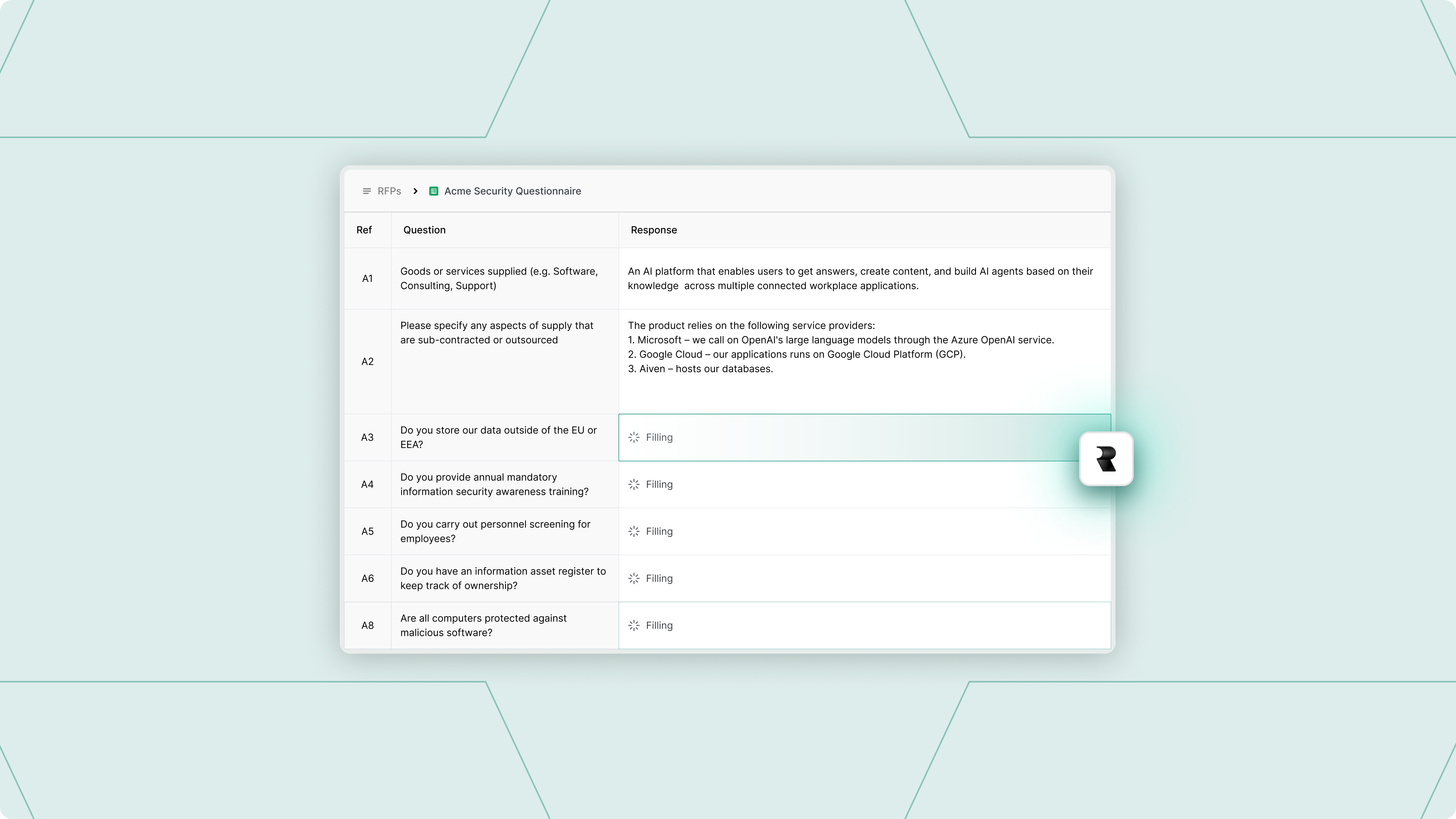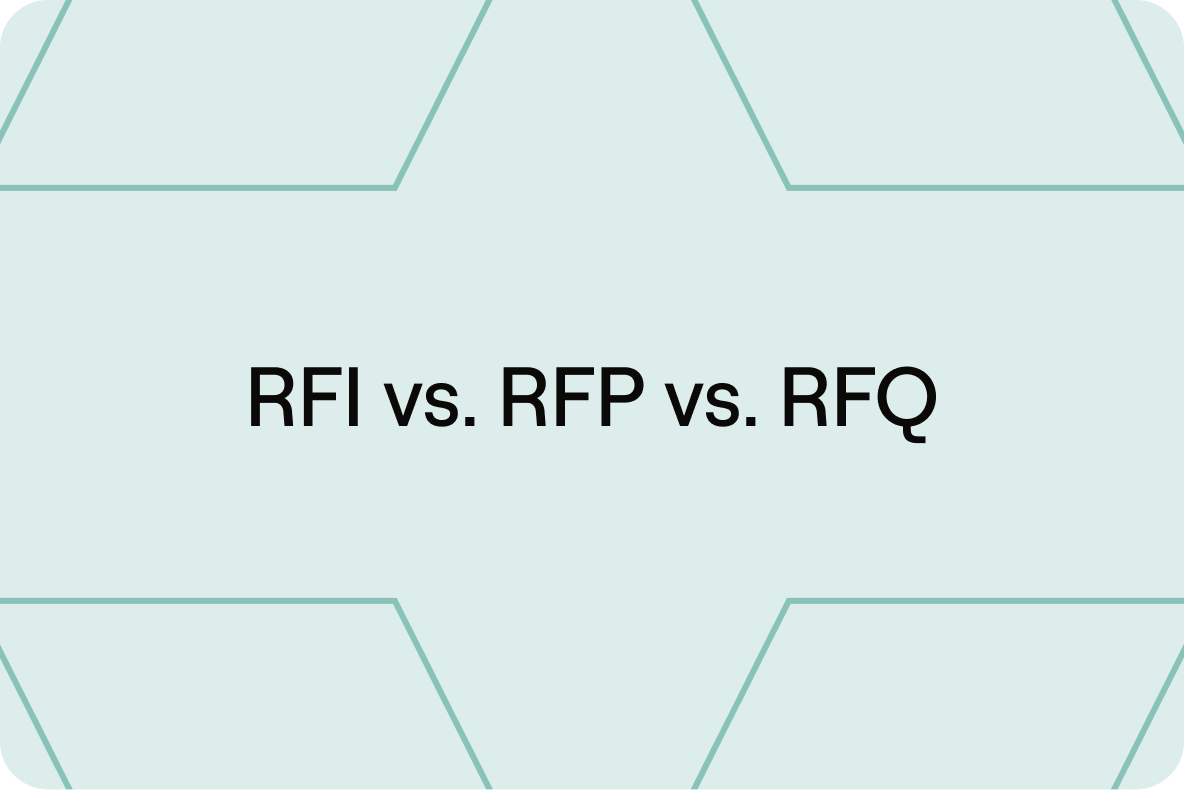The moment an email lands with a subject line containing "RFP," "RFI," or "RFQ," a familiar mix of excitiment and panic sets in across the revenue team. Sales wants to win the deal. Sales Engineering groans at the impending workload. RevOps worries about the resource drain.
The problem? Most organizations treat all three of these the same.
Misunderstanding the buyer’s intent leads to misallocated resources, slow response times, and low win rates. You end up spending 40 hours customizing a document when the buyer only needed a price list, or worse, losing a large deal because you focused on features when the buyer needed a strategic partnership proposal.
To win consistently, revenue leaders must move past the acronyms and understand the strategic difference between different RFZs from RFIs to RFPs, and RFQs.
This guide will break down the purpose of each document and show you how to automate your response strategy to focus your human capital on selling value, not filling questionnaires.
What is an RFX?

RFX stands for Request for X, and it serves as the universal umbrella term for formal procurement documents used by buying organizations. When a buyer issues an RFX, it signals a structured, formal buying process. They are serious about making a purchase, but the specific document type tells you how far along they are in their decision-making process.
The three main types of RFX documents, RFI, RFP, and RFQ, represent distinct, sequential stages in the buyer’s journey:
- RFI (Request for Information): The Discovery Phase
- RFP (Request for Proposal): The Solution Phase
- RFQ (Request for Quotation): The Transaction Phase
Understanding this sequence is the first step in correctly qualifying the deal and allocating your valuable Sales Engineering and RevOps resources.
Request for information (RFI)
An RFI is the earliest and least binding of the three documents.
What is an RFI?
An RFI meaning is simple: Request for Information. It is a preliminary, exploratory document used by a company that knows it has a problem but is still trying to understand the market, the available solutions, and the capabilities of potential vendors.
The primary purpose of an RFI is fact-finding. The buyer is casting a wide net to gather general data for planning purposes.
- RFI stands for: Request for Information.
- Buyer’s Intent: "What is out there? What are the industry standards? Who can even solve this problem?"
- Document Focus: High-level company background, product overviews, general capabilities, and market positioning.
The seller’s strategic response to an RFI
When you receive a request for information, your goal is not to close the deal, but to qualify for the next stage (the RFP).
Focus on thought leadership and building credibility:
- Keep it High-Level: Avoid deep technical dives or specific pricing. The buyer is not ready for that, and over-investing now is a waste of resources.
- Showcase Expertise: Demonstrate that you understand the problem better than your competitors. Position your company as an industry leader.
- Low Resource Allocation: This is a low-qualification stage. Use automated tools to generate quick, accurate capability summaries. Save your senior SEs for the RFP stage.
Request for proposal (RFP)
The RFP is the most complex and resource-intensive document, typically following a successful RFI response.
What is an RFP?
An RFP meaning is Request for Proposal. It is a formal document soliciting a detailed, customized solution to a clearly defined set of business requirements. The buyer has a clear understanding of their needs and is ready to evaluate specific, tailored solutions.
The RFP outlines the project scope, defines technical and functional requirements, and specifies the evaluation criteria. The buyer is looking for a creative, comprehensive proposal that demonstrates how you will solve their problem and what unique value you bring.
- RFP stands for: Request for Proposal.
- Buyer’s Intent: "We know what we need. Show us your best, most customized solution, and prove your value."
- Document Focus: Detailed technical specifications, implementation plans, project timelines, service level agreements (SLAs), and total cost of ownership (TCO).
The seller’s strategic response to an RFP
This is the high-stakes phase where you must differentiate your offering.
Focus on customization, technical depth, and demonstrating unique value:
- Customization is Key: Every answer must be tailored to the client’s specific requirements. Generic answers signal a lack of commitment or understanding.
- Involve the Experts: This stage requires heavy input from Sales Engineers, Solutions Architects, and Legal teams. The quality of the technical response is often the deciding factor.
- Sell Value, Not Price: While cost is included, the evaluation criteria often weigh technical merit, implementation approach, and vendor experience higher than price alone. Your request for proposal must sell the value that justifies your price.
Request for quotation (RFQ)
The RFQ is the final, most transactional document in the procurement cycle.
What is an RFQ?
An RFQ meaning is Request for Quotation. It is a highly specific, price-focused document used to obtain pricing for specific products or services. The buyer uses an RFQ when they know exactly what they want, often down to the SKU number or specific service hours, and are focused purely on securing the best price.
The RFQ process occurs at the final stage of procurement when a purchase is imminent. It contains detailed requirements and rarely includes open-ended questions because the buyer has already made their technical decision.
- RFQ stands for: Request for Quotation.
- Buyer’s Intent: "We have chosen the solution. Now, who can give us the best price and terms?"
- Document Focus: Pricing tables, payment terms, delivery schedules, and contractual terms.
The seller’s strategic response to an RFQ
When you receive a request for quote, the time for selling value is over. This is a negotiation on cost.
Focus on competitive pricing, favorable terms, and speed:
- Accuracy Over Creativity: Do not try to re-sell the solution or offer creative alternatives. Simply provide the requested pricing and terms accurately and quickly.
- Efficiency Wins: Since the decision is often based on cost and speed of response, efficiency is paramount. Automate the retrieval of verified pricing and technical specs to ensure a rapid turnaround.
- Final Stage: This is the last hurdle before the purchase order. Ensure all internal stakeholders (Finance, Legal) are aligned to prevent last-minute delays.
A decision matrix: RFI vs. RFP vs. RFQ
The difference between RFI, RFP, and RFQ is the difference between discovery, solution, and transaction. Use this table to instantly determine the buyer's intent and allocate your resources correctly.
Automate RFX responses with Realm

Realm is designed to streamline your entire response process, including RFPs, RFIs, RFQs, and security questionnaires such as VSQs, CAIQs, SIGs, DDQs. By connecting directly to your company's existing knowledge base, Realm's AI agents can automate up to 80% of your response drafting, allowing your team to focus on review and strategic customization.
7 steps to automate RFX responses
Realm provides a centralized platform for managing the entire bidding process, from initial upload to final submission.
1. Upload the questionnaire
Start by uploading the unfilled RFX or questionnaire file directly to the Realm platform. Realm supports diverse file formats, including Excel, PDF, and Word.
2. Analysis and parsing
Realm automatically analyzes the document, recognizing which questions, columns, or tables require a response. The system breaks the RFP down into manageable sections for processing.
3. Choose your AI Agent
You can set up specialized AI Agents for different question types, product verticals, or customer segments. Each Agent can be grounded in a specific subset of your knowledge base to ensure the most relevant information is used.
4. Automate drafting
Realm drafts comprehensive, accurate, and compelling responses in your company’s language and tone of voice. Every answer is grounded in your company’s verified knowledge base, including past winning proposals. To ensure accuracy and easy verification, Realm cites the sources it references for every generated answer. This process prevents AI "hallucinations" by only using your approved, factual content.
5. Review and collaborate
AI drafts are complete in minutes, you can seamlessly review and finalize the responses with your team. You can manually edit the answer, approve it if it's final, or write a follow-up prompt asking the AI for edits or additions. You can also assign specific questions or sections to subject-matter experts (SMEs) for finalization.
6. Export and submit
Once all answers have been reviewed and approved, you can export the finalized document. The exported file will maintain the exact structure and formatting of the original RFP spreadsheet or document.
7. Repurpose winning responses
After the RFP is completed and approved, the finalized responses are automatically added back into your knowledge base under a source called “RFPs”. This ensures that future AI Agents will automatically draw on your latest winning answers, continually improving response quality and consistency.
Final thoughts on RFXs
The distinction between RFIs, RFPs and RFQs is the difference between discovery, solution, and transaction. For anyone handling RFXs, mastering this distinction is non-negotiable. It dictates where you spend your most valuable resources and determines your win rate. Master the RFX decision matrix, leverage AI automation like Realm to handle the volume and complexity with accuracy, and focus your human capital on the strategic work of selling value, not filling questionnaires. That is how you accelerate deal velocity and drive predictable revenue growth.


